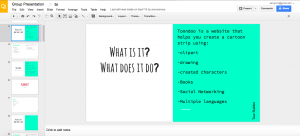Flipping the classroom seems to be the newest buzzword in education, both in higher ed and in k12 but what are the benefits of this method and what exactly is a “flipped classroom”?
Flipped Classroom
A flipped classroom is a reversal of the norm, where class time that is usually spent lecturing while students dutifully take notes, is used for a more hands on approach such as group work or problem solving. All lectures or readings should be done before class, so that students have knowledge of the subject matter when they walk into class and can use the class time to delve deeper into the material. Many professors suggest a short quiz or worksheet to be completed before coming to class to keep students on track and engaged in the process.
What are the benefits of this method?
A great resource for these questions can be found in a book called “Flip Your Classroom” by Jonathan Bergmann and Aaron Sams. In it they discuss several great reasons to flip your classroom.
1. Flipping helps busy students
Some students (especially in college) are juggling academics, extracurriculars and jobs. Things come up and not all students are able to attend every class. Flipping the classroom allows them to stay caught up on the material and even work ahead if they know they will be out.
2. Flipping helps struggling students
Students that tend to struggle to learn a concept can pause the lecture, lookup any information they might not understand and then resume. They are also able to rewind as many times as needed until they fully understand the concept.
3. Flipping helps students of all abilities excel
Students that struggle will have more time to absorb the material and students that excel and get bored are able to investigate the material more fully. They are able to learn things they may not have had time to learn in a regular setting classroom.
4. Flipping increases student-teacher interaction
Flipping allows professors to help their students in a more one-on-one or one-on-group capacity. It gives time for small group lecturing to groups that may need more help and gives time to move about the classroom conversing with each student.
5. Flipping allows teachers to know their students better
Instead of lecturing at the front of the classroom while a sea of eyes stares back at you, flipping your classroom allows you to take time to walk around your class and get to know your students. This gives them a connection to their learning.
6. Flipping allows for real differentiation
Not only do the students have control of the lecture and what parts they need repeated or what parts they can move through quicker, they also have the ability to work at a higher level in class or work closely with their professor on harder concepts.
7. Flipping changes classroom management
While the professor stands at the front of the room lecturing, it is easy for students to be on their phones or looking at Facebook but in a flipped classroom they are engaged. They are working on concepts, they are thinking deeper and they are taking their knowledge to the next level.
Flipping the classroom research
One study (Deslauriers et al., 2011) found that students who participated in a flipped classroom vs. an interactive lecture classroom were much more engaged and did about 33% better on their final evaluation. Both classes were given eleven weeks of interactive lecture and at the twelfth week one class was flipped. The classes showed no difference in score or engagement in the first eleven weeks.
Another study by Fautch (2014) conducted on an organic chemistry 1 course found that students showed greater comprehension of the material and tended to improve their performance on exams. Students also felt more knowledgeable and more comfortable with the course material.
Weaver and Sturtevant (2015) conducted a three year study at Purdue University within their chemistry major and found that students in a flipped classroom, throughout their studies, scored significantly higher when compared to their previous scores in a traditional classroom setting. The majority of students had positive feelings about the format of the classroom.
How do I flip my classroom
There are numerous benefits to flipping your classroom and it doesn’t have to be an abstract concept anymore. Flipping your classroom allows students to take pride and ownership of their learning. This method allows them to explore areas of the curriculum that they may not have had time to explore in a traditional classroom or master areas that they may have been weak in. Check out any of TLT’s training sessions about flipping your classroom at tlt.eventbrite.com to get started!
Sources
DesLauriers L, Schelew E, and Wieman C (2011). Improved learning in a large-enrollment physics class. Science 332: 862-864.
Fautch, J. M. (2015). The flipped classroom for teaching organic chemistry in small classes: Is it effective? Chem. Educ. Res. Pract., 16(1), 179-186.
Weaver, G. C., & Sturtevant, H. G. (2015). Design, Implementation, and Evaluation of a Flipped Format General Chemistry Course. J. Chem. Educ. Journal of Chemical Education, 92(9), 1437-1448
















